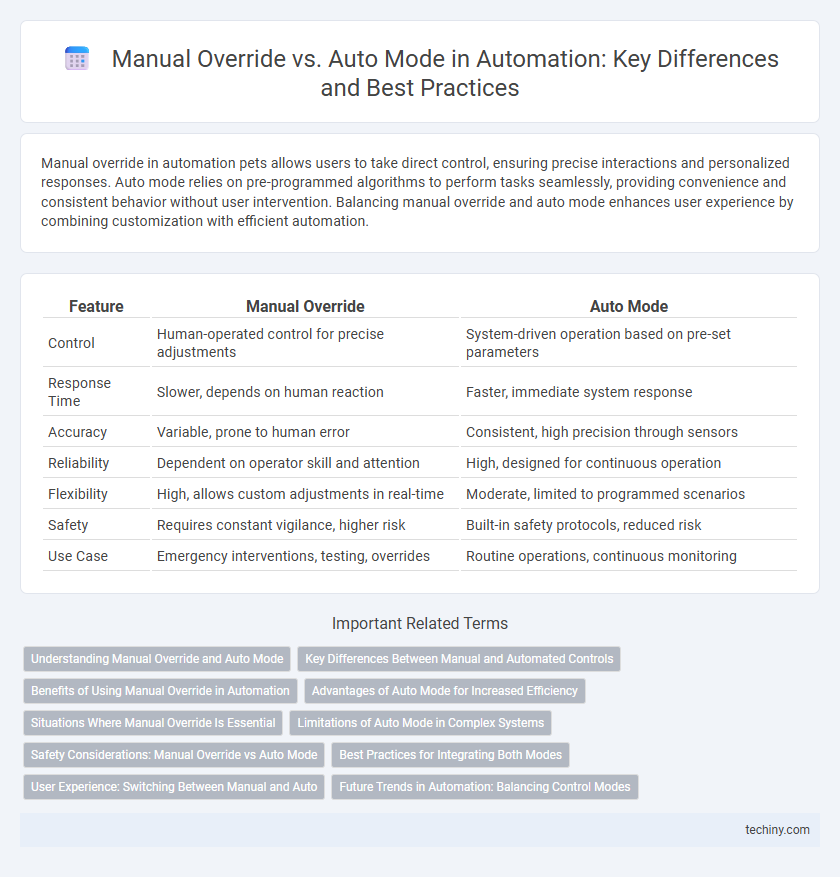Manual override in automation pets allows users to take direct control, ensuring precise interactions and personalized responses. Auto mode relies on pre-programmed algorithms to perform tasks seamlessly, providing convenience and consistent behavior without user intervention. Balancing manual override and auto mode enhances user experience by combining customization with efficient automation.
Table of Comparison
| Feature | Manual Override | Auto Mode |
|---|---|---|
| Control | Human-operated control for precise adjustments | System-driven operation based on pre-set parameters |
| Response Time | Slower, depends on human reaction | Faster, immediate system response |
| Accuracy | Variable, prone to human error | Consistent, high precision through sensors |
| Reliability | Dependent on operator skill and attention | High, designed for continuous operation |
| Flexibility | High, allows custom adjustments in real-time | Moderate, limited to programmed scenarios |
| Safety | Requires constant vigilance, higher risk | Built-in safety protocols, reduced risk |
| Use Case | Emergency interventions, testing, overrides | Routine operations, continuous monitoring |
Understanding Manual Override and Auto Mode
Manual override allows operators to take direct control of automated systems, ensuring flexibility and immediate response in complex or unexpected situations. Auto mode relies on pre-programmed algorithms and sensors to perform tasks with consistent precision and efficiency, minimizing human intervention. Understanding the balance between manual override and auto mode is crucial for optimizing system reliability, safety, and performance in automation environments.
Key Differences Between Manual and Automated Controls
Manual override allows operators to directly control processes, providing flexibility and immediate response during unexpected situations or system failures. Auto mode relies on pre-programmed algorithms and sensors to optimize efficiency, consistency, and accuracy without human intervention. Key differences include the level of human involvement, speed of response, and adaptability to complex scenarios.
Benefits of Using Manual Override in Automation
Manual override in automation provides enhanced control and flexibility, allowing operators to intervene directly during system anomalies or unexpected conditions. This capability minimizes downtime by enabling quick adjustments without waiting for automated protocols to respond, which is crucial in critical industries like manufacturing and energy. Employing manual override also facilitates precise calibration and maintenance, ensuring optimal performance and safety in automated processes.
Advantages of Auto Mode for Increased Efficiency
Auto mode in automation systems significantly enhances operational efficiency by consistently maintaining optimal performance without human intervention. It reduces the risk of errors and downtime through real-time adjustments and continuous monitoring of processes. Utilizing auto mode minimizes labor costs and accelerates task completion, resulting in higher productivity and streamlined workflows.
Situations Where Manual Override Is Essential
Manual override becomes essential in automation systems during emergency scenarios where immediate human intervention is required to prevent equipment damage or ensure safety. It allows operators to bypass pre-programmed controls when sensors malfunction or unexpected conditions arise, providing precise control that automated systems cannot guarantee. Critical industrial processes, power plants, and autonomous vehicles rely on manual override to maintain operational integrity and prevent catastrophic failures.
Limitations of Auto Mode in Complex Systems
Auto mode in complex systems often struggles with unpredictable variables and nuanced decision-making, limiting its effectiveness in real-time problem-solving. Manual override allows human operators to intervene and adjust processes when automation cannot interpret ambiguous data or unexpected scenarios. This synergy ensures higher system reliability by compensating for auto mode's inability to handle intricate, dynamic conditions independently.
Safety Considerations: Manual Override vs Auto Mode
Manual override enhances safety by allowing human intervention to promptly address unexpected system failures or anomalies, reducing the risk of accidents. Auto mode ensures consistent operation through predefined safety protocols and real-time sensor monitoring, minimizing human error. Balancing both modes optimizes overall system safety by combining automated precision with human judgment.
Best Practices for Integrating Both Modes
Balancing manual override and auto mode in automation systems requires establishing clear protocols that define when and how to switch between modes, ensuring safety and efficiency. Incorporating real-time monitoring and feedback loops allows operators to intervene precisely without disrupting automated workflows. Best practices include user training, fail-safe mechanisms, and regular system audits to optimize integration and minimize operational risks.
User Experience: Switching Between Manual and Auto
Switching between manual override and auto mode enhances user experience by providing flexibility and control tailored to varying needs and environmental conditions. Manual override allows precise adjustments when automatic settings fall short, ensuring reliability in unpredictable scenarios. Auto mode simplifies operation by optimizing performance based on real-time data, reducing user intervention and minimizing errors.
Future Trends in Automation: Balancing Control Modes
Future trends in automation emphasize a dynamic balance between manual override and auto mode, integrating advanced AI to enhance flexibility and safety. Adaptive systems increasingly allow seamless switching, ensuring human intervention during anomalies while maximizing operational efficiency in standard conditions. Industry 4.0 drives the development of intelligent control architectures combining predictive analytics and real-time decision-making to optimize performance and reliability.
Manual Override vs Auto Mode Infographic

 techiny.com
techiny.com